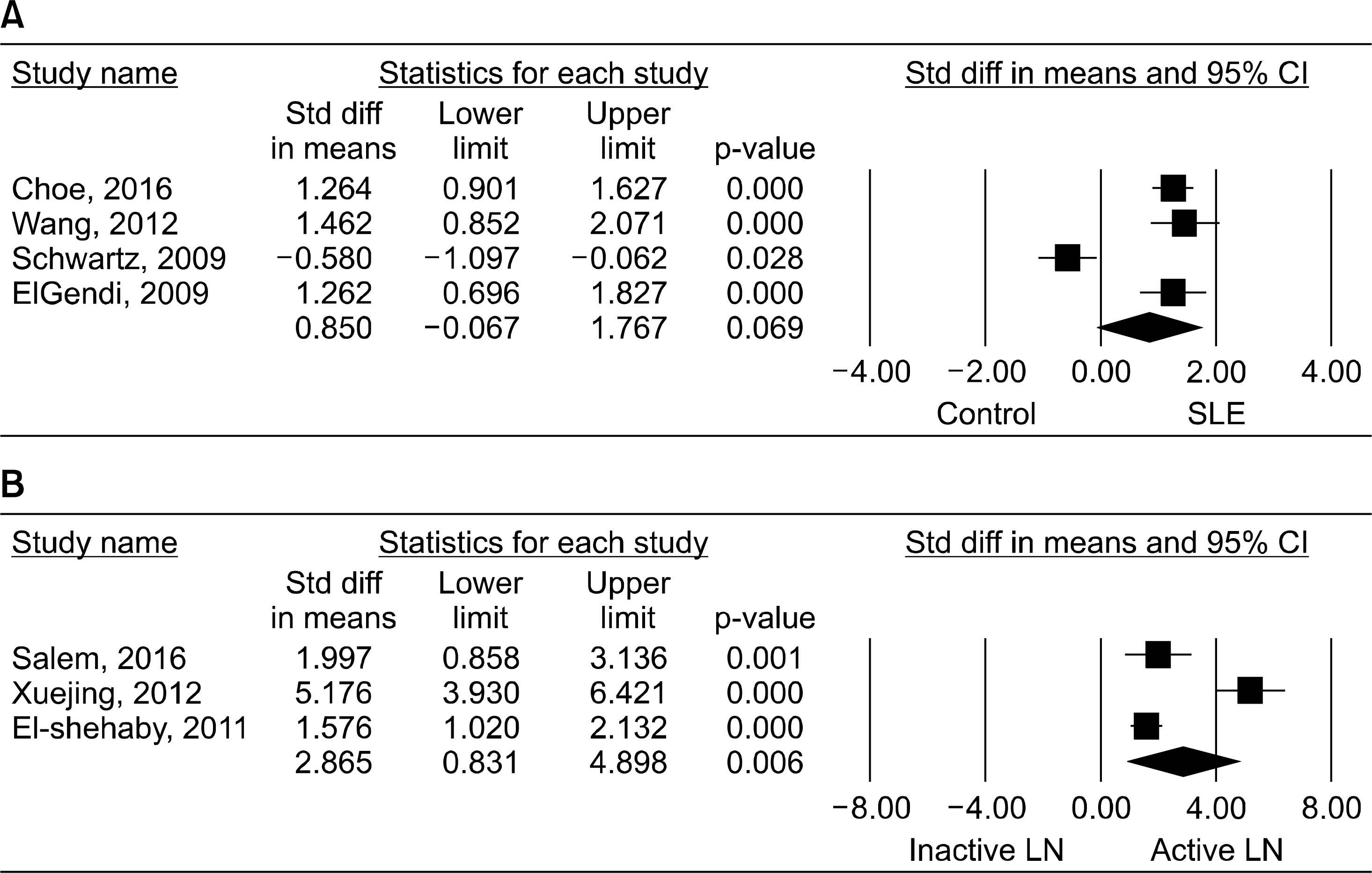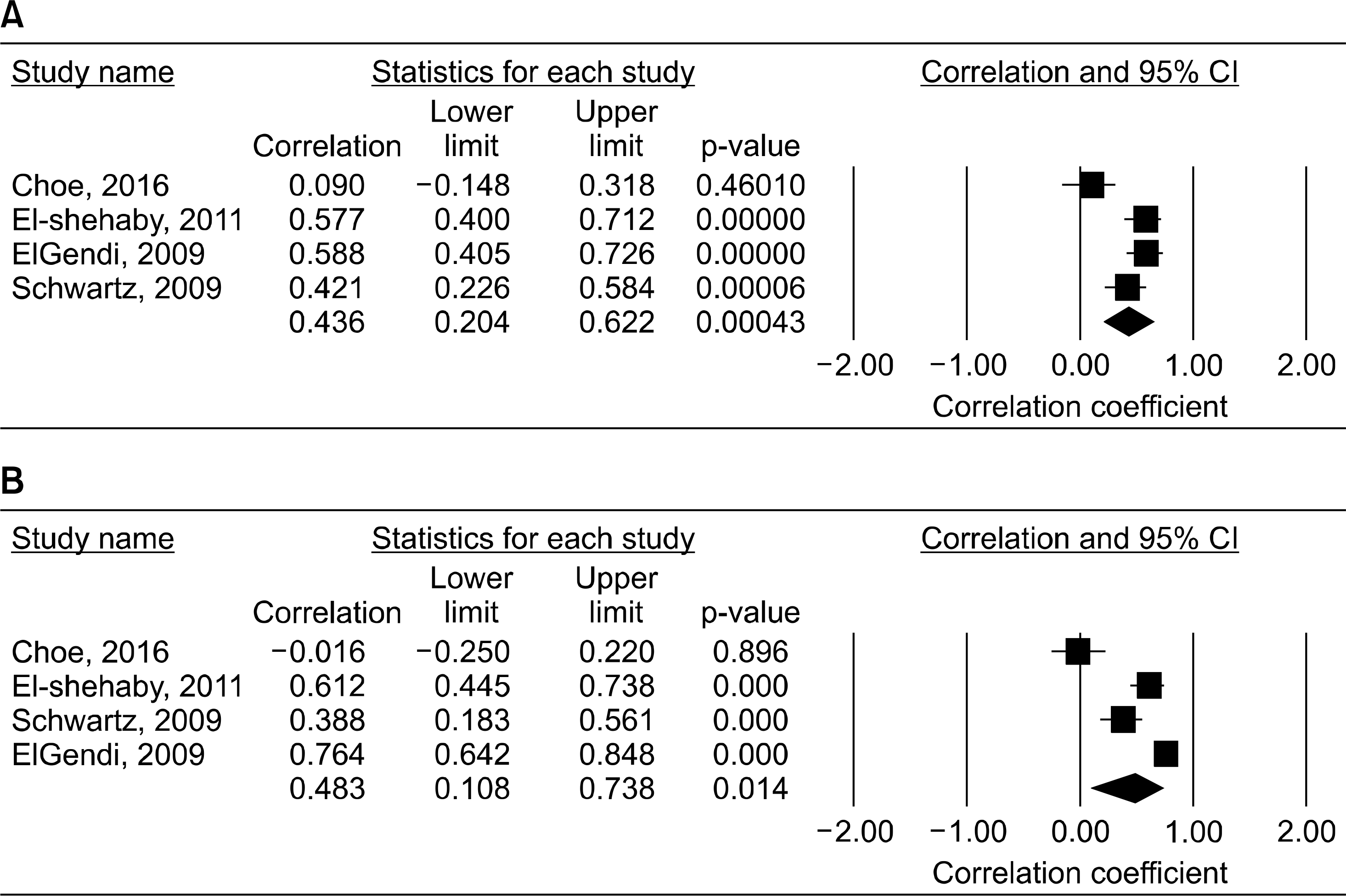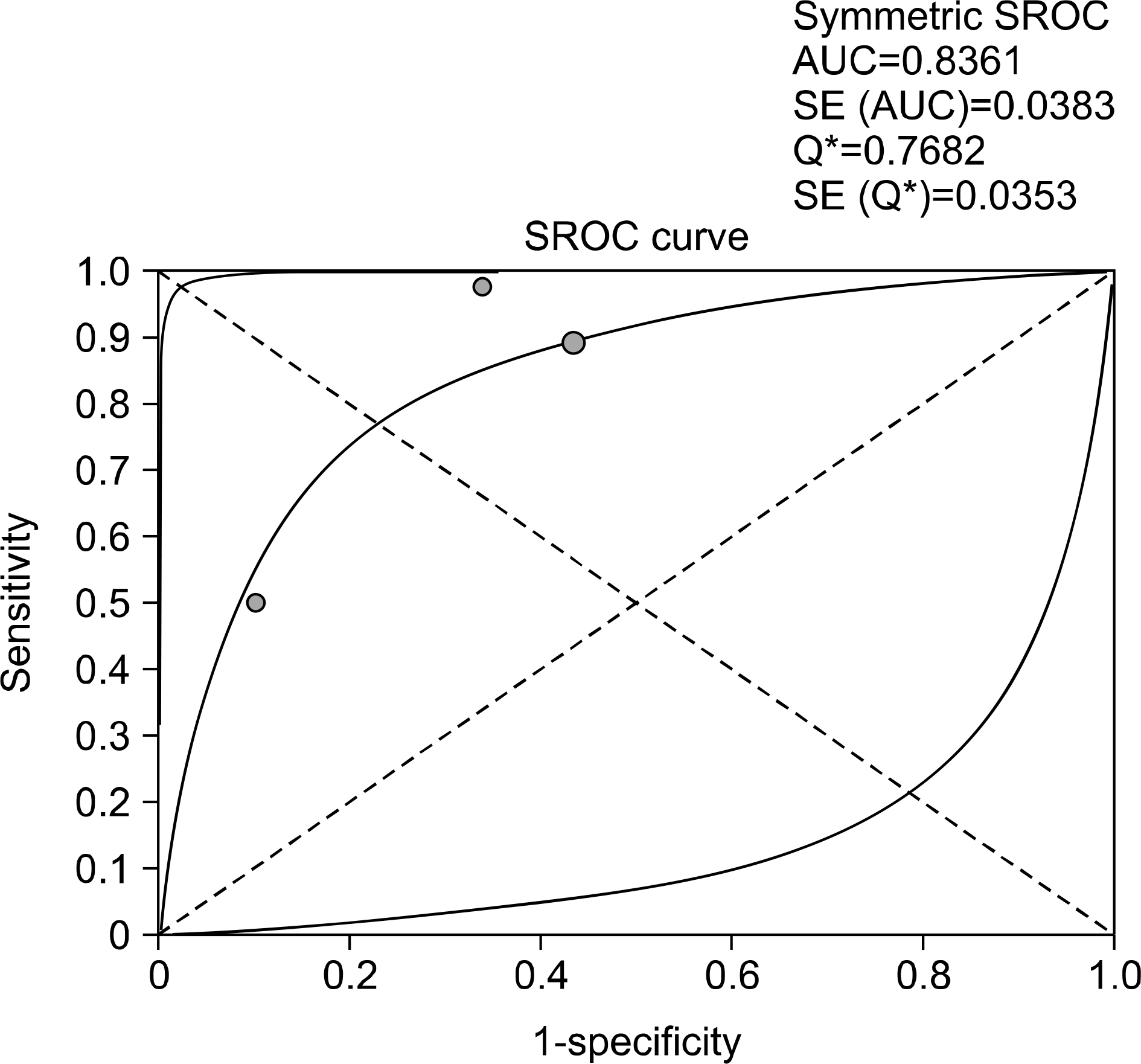Abstract
Objective
This study evaluates serum or urinary tumor necrosis factor-like weak inducer of apoptosis (TWEAK) as a biomarker for lupus nephritis (LN).
Methods
We conducted a meta-analysis examining serum or urinary TWEAK levels in patients with systemic lupus erythematosus (SLE), patients with LN (active or inactive), and healthy controls. We tabulated correlation coefficients between urinary TWEAK level and total or renal SLE Disease Activity Index (tSLEDAI or rSLEDAI).
Results
Eight studies were included in this meta-analysis. The meta-analysis revealed that serum TWEAK levels tended to be higher in patients with SLE than in controls (standard mean difference [SMD]=0.850, 95% confidence interval [CI]=−0.067∼1.767, p=0.069). Urinary TWEAK was significantly higher in patients with active LN than in those with inactive LN (SMD=2.865, 95% CI=−0.831∼4.898, p=0.006). In addition, urinary TWEAK was positively associated with tSLEDAI and rSLEDAI (correlation co-efficient=0.436, 95% CI=0.204∼0.622, p=4.3×10−4; correlation coefficient=0.483, 95% CI=0.108∼0.738, p=0.014). Pooled sensitivity and specificity of urinary TWEAK for diagnosis of LN were 81.3% (95% CI, 73.3∼87.8) and 76.0% (95% CI, 66.3∼84.2), indicating good diagnostic accuracy.
Go to : 
REFERENCES
3. Ogura Y, Mishra V, Hindi SM, Kuang S, Kumar A. Proinflammatory cytokine tumor necrosis factor (TNF)-like weak inducer of apoptosis (TWEAK) suppresses satellite cell self-renewal through inversely modulating Notch and NF-κ B signaling pathways. J Biol Chem. 2013; 288:35159–69.
4. Winkles JA. The TWEAK-Fn14 cytokine-receptor axis: discovery, biology and therapeutic targeting. Nat Rev Drug Discov. 2008; 7:411–25.

5. Campbell S, Burkly LC, Gao HX, Berman JW, Su L, Browning B, et al. Proinflammatory effects of TWEAK/ Fn14 interactions in glomerular mesangial cells. J Immunol. 2006; 176:1889–98.
6. Zhao Z, Burkly LC, Campbell S, Schwartz N, Molano A, Choudhury A, et al. TWEAK/Fn14 interactions are instrumental in the pathogenesis of nephritis in the chronic graft-versus-host model of systemic lupus erythematosus. J Immunol. 2007; 179:7949–58.

7. Michaelson JS, Wisniacki N, Burkly LC, Putterman C. Role of TWEAK in lupus nephritis: a bench-to-bedside review. J Autoimmun. 2012; 39:130–42.

8. Chicheportiche Y, Bourdon PR, Xu H, Hsu YM, Scott H, Hession C, et al. TWEAK, a new secreted ligand in the tumor necrosis factor family that weakly induces apoptosis. J Biol Chem. 1997; 272:32401–10.

9. Sanz AB, Sanchez-Niño MD, Ortiz A. TWEAK, a multifunctional cytokine in kidney injury. Kidney Int. 2011; 80:708–18.

10. Moher D, Liberati A, Tetzlaff J, Altman DG. PRISMA Group. Preferred reporting items for systematic reviews and meta-analyses: the PRISMA statement. PLoS Med. 2009; 6:e1000097.

11. Hozo SP, Djulbegovic B, Hozo I. Estimating the mean and variance from the median, range, and the size of a sample. BMC Med Res Methodol. 2005; 5:13.

12. Ridout KK, Ridout SJ, Price LH, Sen S, Tyrka AR. Depression and telomere length: A meta-analysis. J Affect Disord. 2016; 191:237–47.

13. Egger M, Smith GD, Phillips AN. Meta-analysis: principles and procedures. BMJ. 1997; 315:1533–7.

15. Higgins JP, Thompson SG. Quantifying heterogeneity in a meta-analysis. Stat Med. 2002; 21:1539–58.

16. Walter SD. Properties of the summary receiver operating characteristic (SROC) curve for diagnostic test data. Stat Med. 2002; 21:1237–56.

17. Zamora J, Abraira V, Muriel A, Khan K, Coomarasamy A. Meta-DiSc: a software for meta-analysis of test accuracy data. BMC Med Res Methodol. 2006; 6:31.

18. Egger M, Davey Smith G, Schneider M, Minder C. Bias in meta-analysis detected by a simple, graphical test. BMJ. 1997; 315:629–34.

19. Salem MN, Taha HA, Abd El-Fattah El-Feqi M, Eesa NN, Mohamed RA. Urinary TNF-like weak inducer of apoptosis (TWEAK) as a biomarker of lupus nephritis. Z Rheumatol. 2016; Sep 12 [Epub].DOI: DOI:10.1007/s00393-016-0184-1.
20. Choe JY, Kim SK. Serum TWEAK as a biomarker for disease activity of systemic lupus erythematosus. Inflamm Res. 2016; 65:479–88.

21. Xuejing Z, Jiazhen T, Jun L, Xiangqing X, Shuguang Y, Fuyou L. Urinary TWEAK level as a marker of lupus nephritis activity in 46 cases. J Biomed Biotechnol. 2012; 2012; 359647.

22. Wang C, Chen LL, Pan HF, Leng RX, Qin WZ, Ye DQ. Expression of human tumor necrosis factor-like weak inducer of apoptosis in patients with systemic lupus erythematosus. Clin Rheumatol. 2012; 31:335–9.

23. El-Shehaby A, Darweesh H, El-Khatib M, Momtaz M, Marzouk S, El-Shaarawy N, et al. Correlations of urinary biomarkers, TNF-like weak inducer of apoptosis (TWEAK), osteoprotegerin (OPG), monocyte chemoattractant protein-1 (MCP-1), and IL-8 with lupus nephritis. J Clin Immunol. 2011; 31:848–56.

24. Schwartz N, Rubinstein T, Burkly LC, Collins CE, Blanco I, Su L, et al. Urinary TWEAK as a biomarker of lupus nephritis: a multicenter cohort study. Arthritis Res Ther. 2009; 11:R143.

25. ElGendi SS, El-Sherif WT. Anti-C1q antibodies, sCD40L, TWEAK and CD4/CD8 ratio in systemic lupus erythematosus and their relations to disease activity and renal involvement. Egypt J Immunol. 2009; 16:135–48.
26. Schwartz N, Su L, Burkly LC, Mackay M, Aranow C, Kollaros M, et al. Urinary TWEAK and the activity of lupus nephritis. J Autoimmun. 2006; 27:242–50.

27. Lee YH, Song GG. Urinary MCP-1 as a biomarker for lupus nephritis: a meta-analysis. Z Rheumatol. 2016 Jun 9; [Epub].DOI: DOI:10.1007/s00393-016-0109-z.
28. Mok CC. Biomarkers for lupus nephritis: a critical appraisal. J Biomed Biotechnol. 2010; 2010; 638413.

Go to : 
 | Figure 1.Meta-analysis of the relationship between serum TWEAK level and SLE compared with control (A), and between urinary TWEAK level and active LN compared with inactive LN (B). TWEAK: tumor necrosis factor-like weak inducer of apoptosis, SLE: systemic lupus erythematosus, LN: lupus nephritis, CI: confidence interval, Std diff: standardized difference. |
 | Figure 2.Meta-analysis of the correlation coefficient between urinary TWEAK and total SLEDAI (A) and renal SLEDAI (B). TWEAK: tumor necrosis factor-like weak inducer of apoptosis, SLEDAI: systemic lupus erythematosus disease activity index, CI: confidence interval. |
 | Figure 3.Summary receiver-operating characteristic curves for urinary TWEAK for the diagnosis of LN. Solid circles represent individual studies included in this meta-analysis. The curve shown is a regression line that summarizes the overall diagnostic accuracy. TWEAK: tumor necrosis factor-like weak inducer of apoptosis, LN: lupus nephritis, SROC: summary receiver operating characteristic, SE (AUC): standard error of the area under the curve, Q*: an index defined by the point on the SROC curve where the sensitivity and specificity are equal; and SE (Q*): Q* index standard error. |
Table 1.
Characteristics of individual studies included in the meta-analysis
| Author | Country | Number | Age, yr | Disease duration | Main findings | ||
|---|---|---|---|---|---|---|---|
| SLE | Control | SLE | Control | ||||
| Salem, 2016 [19] | Egypt | 14* | 24† | 25.6±10.7* | 27.3±9.0† | 2.2±2.1* | The uTWEAK levels were significantly higher in patients with SLE with active LN compared to those without or with inactive renal disease and normal healthy subjects. |
| Choe, 2016 [20] | Korea | 70 | 61 | 40.4±11.2 | 4.6±9.1 | 6.4±4.4 | sTWEAK might be a serologic biomarker candidate that reflects disease activity and renal involvement in patients with SLE. |
| Xuejing, 2012 [21] | China | 34* | 12† | 14∼53* | 14∼53† | 12.7±3.4* | uTWEAK levels were correlated with all active indexes of LN, suggesting its potential role as a novel biomarker of active lupus nephritis. |
| Wang, 2012 [22] | China | 62 | 15 | 34.1±10.0 | 36.6±11.6 | NA | Patients with SLE express low levels of TWEAK mRNA but high levels of sTWEAK. Additionally, sTWEAK level was associated with several clinical manifestations of SLE, indicating that TWEAK may play a complex role in SLE. |
| El-shehaby, 2011 [23] | Egypt | 50* | 23† | 29.1±7.9* | 29.7±8.8‡ | 6.1±4.2* | Urinary levels of TWEAK positively correlate with renal involvement as assessed by rSLEDAI with reasonable sensitivity, specificity, and predictive values to detect LN. |
| Schwartz, 2009 [24] | USA | 30‡ | 61 | 40.4±11.2‡ | 4.6±9.1 | 6.4±4.4 | High uTWEAK levels are indicative of LN, as opposed to non-LN SLE and other healthy and disease control populations, and reflect renal disease activity in longitudinal follow-up. |
| ElGendi, 2009 [25] | Egypt | 47 | 20 | 25.3±7.2 | NA | 25.7±3.1 | sTWEAK may be used as a serum biomarker for the assessment of disease activity and development of LN. |
| Schwartz, 2006 [26] | USA | 83 | NA | 35 | NA | NA | Urinary TWEAK levels may be useful as a novel biomarker in LN. |
Values are presented as number and mean±standard deviation. SLE: systemic lupus erythematosus, TWEAK: tumor necrosis factor-like weak inducer of apoptosis, uTWEAK: urinary TWEAK, LN: lupus nephritis, sTWEAK: serum TWEAK, NA: not available, rSLEDAI: renal SLE disease activity index. Definition of Active LN in this analysis: rSLEDAI score ≥4.
Table 2.
Meta-analysis of serum and urinary TWEAK levels in lupus nephritis
Table 3.
Meta-analysis of the correlation coefficient between urinary TWEAK level and SLE and renal activity, and the diagnosis of LN




 PDF
PDF ePub
ePub Citation
Citation Print
Print


 XML Download
XML Download